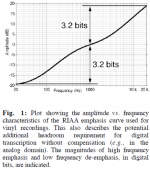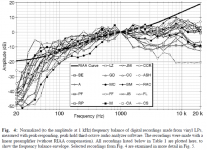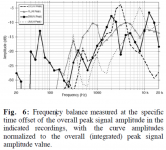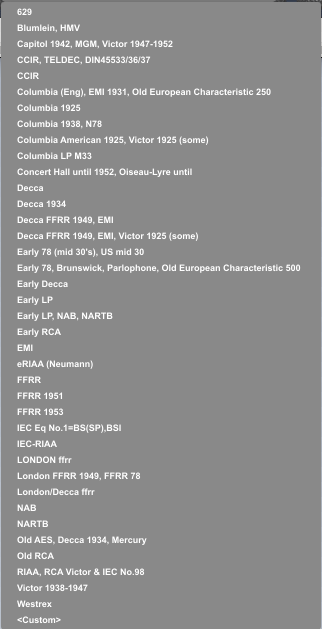I thought having the PC do all the work was a neat solution until I heard the results.
Well this is not true by measurement and simply wrong. Unfortunately Channel D has apparently removed the AES paper with the measurements and data.
You can find a very basic DSD ADC in this thread:
Very basic DSD ADC made with op-amps and logic gates
but I haven't figured out yet how to get the data into a computer.
Thank you.
I recently bought an alesis ml 9600 to record lps with the intention of doing some minor updates. After opening it I see it is not the easiest thing to work on so I will probably just go with external ad/da. The recorder is relatively inexpensive now and the files are easy enough to move to a computer via CDR. If I wasn’t so cheap I would have bought a Tascam da-3000 and been done with it.
A lot has already been written in this thread.
Digitizing vinyl
http://www.channld.com/aes123.pdf
George
Digitizing vinyl
you will forfeit at least 20 db in the S/N as it adjusts the signal to the RIAA curve. If you use a phonograph preamp to feed the PC with an already equalized signal then you will not lose the 20 db. Your ultimate S/N will that of the phono preamp. I thought having the PC do all the work was a neat solution until I heard the results.
Well this is not true by measurement and simply wrong. Unfortunately Channel D has apparently removed the AES paper with the measurements and data.
http://www.channld.com/aes123.pdf
George
Hi, Curious. A bit OT and likely much more than the OP wanted... I would like to have the link on the data about Audacity and RIAA. Those results differ from mine and I am always open to new ideas.
George you can find anything. I confirmed their results, and note Audacity's RIAA filter is linear phase you can use the Nyquist prompt to do a proper minimum phase IIR RIAA.
A lot has already been written in this thread.
Digitizing vinyl
http://www.channld.com/aes123.pdf
George
Thanks George, that's an awesome doc!
Filter Reconstruction and Program Material Characteristics Mitigating Word Length Loss in
Digital Signal Processing-Based Compensation Curves used for Playback of Analog Recordings
R. S. Robinson 2007



...
"Setting aside the benefits of word length recovery in the bass because of digital compensation, as proven above: if truncation does occur, bass resolution truncation represents a more desirable alternative to resolution truncation in the midrange and treble; further, the perception of any “disadvantage” to word length truncation in the bass is unfounded, because of being more than compensated by the feature of digital resolution enhancement in the treble.
6. CONCLUSION
Digitally implemented de-emphasis filtering, used for playback of vinyl LP recordings, enhances the digital word length at low frequencies, similar to the reconstruction filters used for the playback of one-bit digital audio streams. The reconstructive properties of digital de-emphasis filtering, as shown here, in conjunction with the characteristics of most program material, will cause a typical overall bass resolution truncation of only one bit or less, significantly lower than the nearly 7 bits predicted by a casual analysis of digitally realized frequency emphasis playback compensation.
Exceptional, uncommonly encountered program material may cause a worst case bass truncation of approximately three bits, which is negligible considering the 24 bit resolution capability of modern analog to digital converters. In cases where bass word length truncation does occur, the disadvantage is balanced by the complementary enhancement of digital resolution, due to treble preemphasis, in the frequency range where human hearing is at its most sensitive.
Last edited:
I have a copy of the Bob Marley LP that I can use to set a worst case recording level. An interesting experiment might be to make a simultaneous recording of it using both techniques and run them through diffmaker.
Another technique for checking on levels is to take a very dynamic recording and apply inverse RIAA I would think that would give a good answer on how much allowance you need for crest factor increase. Another thing to remember is that ticks and pops do not see pre-emphasis so they don't figure into this and in fact it is worth studying pre vs post RIAA removal but there is only so much time.
Another technique for checking on levels is to take a very dynamic recording and apply inverse RIAA I would think that would give a good answer on how much allowance you need for crest factor increase. Another thing to remember is that ticks and pops do not see pre-emphasis so they don't figure into this and in fact it is worth studying pre vs post RIAA removal but there is only so much time.
Last edited:
Right Scott. I had good results following Website of Wayne Stegall - Digital Phono Equalization (your suggestion)and note Audacity's RIAA filter is linear phase you can use the Nyquist prompt to do a proper minimum phase IIR RIAA
Just type the following:
(biquad-m s 1.315951e-02 -1.273543e-02 0.000000e+00 1.000000e+00 -1.867054e+00 8.674785e-01)
George
Attachments
Right Scott. I had good results following Website of Wayne Stegall - Digital Phono Equalization (your suggestion)
Just type the following:
(biquad-m s 1.315951e-02 -1.273543e-02 0.000000e+00 1.000000e+00 -1.867054e+00 8.674785e-01)
George
Don't forget the coefficients are different for each sampling rate, Bob Orban's are exact and the whole list is in my article as well as two biquad one's that get to micro-dB's of accuracy if you're obsessive like the Channel D guys.
As you know miniDSP has no problem running these real time.
For sure.
Interested participants will benefit if they read the "Digitizing Vinyl" thread.
George
Interested participants will benefit if they read the "Digitizing Vinyl" thread.
George
I have a copy of the Bob Marley LP that I can use to set a worst case recording level. An interesting experiment might be to make a simultaneous recording of it using both techniques and run them through diffmaker.
...

"...
Fig. 6 shows the peak frequency balance measured at the specific location (in time) of the peak amplitude of those recordings which were found to exhibit greater degrees of high frequency emphasis (as shown in Figs. 4 and 5).
The plot is scaled to show the uppermost 30 dB of amplitude, and the curves were normalized to the overall peak level of the recording (because their coherent sum determines the peak level). Generally, for recordings exhibiting greater high frequency emphasis, the overall program peak correlated with a peak in high frequency content.
BM, Bob Marley & the Wailers, Natty Dread, Island, 17.5 (Right)
The Bob Marley and the Wailers recording is unique in that the program peak level simultaneously contains significant amounts of energy in more than one frequency region: low bass (in the 63 Hz, third octave band), midrange (2 kHz) and treble (12.5 kHz). The Liszt piano concerto also was unusual in that the emphasis of the high frequency balance at the program peak position is at a lower frequency (4 kHz), compared to that for the entire recording (16 kHz, Fig. 5).
Most of the other recordings also have significant high frequency content at the signal peak, but exhibit only one prominent frequency peak in the signal at the location of the overall signal peak, as shown, for example:
Clifton Chenier (3.15 kHz),
Joni Mitchell (8 kHz),
Led Zeppelin (10 kHz),
Pink Floyd (10-12.5 kHz);
and those not shown in Fig. 6: Magazine (6.3-8 kHz), Ash (8 kHz),
Creedence Clearwater Revival (10 kHz).
This supports the validity of the peak responding / peak hold analysis presented above; all peaks in Figs. 4 and 5 represent instantaneous values at particular frequencies at different times in the recording and don’t necessarily sum coherently and simultaneously; otherwise, the result might be more akin to noise, not music.
..."
Last edited:
If I wasn’t so cheap I would have bought a Tascam da-3000 and been done with it.
Would be interesting to use one of these for playback of music library 🙂 Wonder how the DAC sounds compared to others.
Hrm I am wondering if I could also use the Tascam DA-3000 as the DAC for my PC. I hear such great things about it. Would save me from having to DIY my own DAC if it is really good.
Could i just leave my PC plugged into it and it will output the analog to my preamp even when not recording?
That way it could be dual purpose. For ripping LP and as my DAC.
Could i just leave my PC plugged into it and it will output the analog to my preamp even when not recording?
That way it could be dual purpose. For ripping LP and as my DAC.
You could. And in that price range there are a number of very good devices used by the pro world. Motu and Sound Devices are industry standards, just for comparisons sake.
From the Tascam marketing blurb
Clearly designed rather than glommed 🙂
Operational amplifiers have a great impact on audio quality, so we carefully selected the NJM2114 and NE5532. In addition, we selected low-impedance capacitors featuring low resistance, low noise and high precision to emphasize audio quality.
Clearly designed rather than glommed 🙂
View attachment 680425
Fig. 6 shows the peak frequency balance measured at the specific location (in time) of the peak amplitude of those recordings which were found to exhibit greater degrees of high frequency emphasis (as shown in Figs. 4 and 5).
I was more making the point if you have an audio track that you want to put on an LP applying RIAA pre emphasis will give you directly the peak value that you need to accommodate.
I use a Korg DS-DAC-10R for ripping my vinyl. Not the cheapest solution but superb results, and you get a high-quality ADC, DAC, software and headphone amp, all for only $469. Amazon.com: Korg DSDAC10R 1BIT USB DSD GATE 4 SOFTWARE TO ANALOG CONVERTER: Musical Instruments
With the Korg, the music never goes through your computer. The ADC is connected to my preamp Tape Out, the DAC is connected to Tape In, just like a tape deck. Music is sent to the laptop as a digital file.
The Korg can record in DSD or up to 192/24 PCM using the supplied AudioGate4 software, with RIAA equalization if required. I prefer Vinyl Studio and PCM because I can effortlessly download album art and track names, complete with track info and timing breaks. I chose to record my vinyl collection to FLAC at 88.2/24.
Vinyl Studio is highly recommended for a one-time expenditure of $30. Record LPs and Tapes to CD and MP3 on your PC or Macintosh
With the Korg, the music never goes through your computer. The ADC is connected to my preamp Tape Out, the DAC is connected to Tape In, just like a tape deck. Music is sent to the laptop as a digital file.
The Korg can record in DSD or up to 192/24 PCM using the supplied AudioGate4 software, with RIAA equalization if required. I prefer Vinyl Studio and PCM because I can effortlessly download album art and track names, complete with track info and timing breaks. I chose to record my vinyl collection to FLAC at 88.2/24.
Vinyl Studio is highly recommended for a one-time expenditure of $30. Record LPs and Tapes to CD and MP3 on your PC or Macintosh
Last edited:
Right Scott. I had good results following Website of Wayne Stegall - Digital Phono Equalization (your suggestion)
Just type the following:
(biquad-m s 1.315951e-02 -1.273543e-02 0.000000e+00 1.000000e+00 -1.867054e+00 8.674785e-01)
George
Without modification those filters are good when sample rate is > 150kHz.
BTW, few years ago I made this app for Cycling '74 Max/MSP :

which supports these EQ curves :

and custom one ofcourse ... all at any current samplerate (I've tested up to 384kHz and IIRC, there were issues when samplerate was set lets say 0.5MHz or higher). Though, RIAA preserts there has not as accurate responses as what Orban's nor Scott's filters but has some tweaking done to improve the accuracy at lower samplerates.
Cycling '74 Max/MSP (min: runtime version) software 5.x or above is needed to run this app. IIRC, Max/MSP up to v. 7.x has the runtime version as a separate installation.
- Status
- Not open for further replies.
- Home
- Source & Line
- PC Based
- Analog to Digital Converter for Recording Vinyl to Computer?
